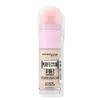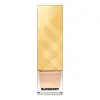What's inside
What's inside
 Key Ingredients
Key Ingredients

 Benefits
Benefits

 Concerns
Concerns

 Ingredients Side-by-side
Ingredients Side-by-side

Water
Skin ConditioningIsohexadecane
EmollientDimethicone
EmollientGlycerin
HumectantIsododecane
EmollientDiisopropyl Adipate
EmollientPEG-9 Polydimethylsiloxyethyl Dimethicone
EmulsifyingPropylene Glycol
HumectantDimethicone Crosspolymer
Emulsion StabilisingDisteardimonium Hectorite
StabilisingPEG-10 Dimethicone
Skin ConditioningCetyl PEG/PPG-10/1 Dimethicone
EmulsifyingPhenoxyethanol
PreservativeKaolin
AbrasiveSodium Chloride
MaskingPolyglyceryl-4 Isostearate
EmulsifyingCaprylyl Glycol
EmollientSynthetic Fluorphlogopite
Butyrospermum Parkii Butter
Skin ConditioningEthylhexylglycerin
Skin ConditioningEthylhexyl Palmitate
EmollientDisodium Stearoyl Glutamate
CleansingAluminum Hydroxide
EmollientSilica Dimethyl Silylate
EmollientButylene Glycol
HumectantSodium Hyaluronate
HumectantTocopherol
AntioxidantHexylene Glycol
EmulsifyingPentaerythrityl Tetra-Di-T-Butyl Hydroxyhydrocinnamate
AntioxidantCitric Acid
BufferingWater, Isohexadecane, Dimethicone, Glycerin, Isododecane, Diisopropyl Adipate, PEG-9 Polydimethylsiloxyethyl Dimethicone, Propylene Glycol, Dimethicone Crosspolymer, Disteardimonium Hectorite, PEG-10 Dimethicone, Cetyl PEG/PPG-10/1 Dimethicone, Phenoxyethanol, Kaolin, Sodium Chloride, Polyglyceryl-4 Isostearate, Caprylyl Glycol, Synthetic Fluorphlogopite, Butyrospermum Parkii Butter, Ethylhexylglycerin, Ethylhexyl Palmitate, Disodium Stearoyl Glutamate, Aluminum Hydroxide, Silica Dimethyl Silylate, Butylene Glycol, Sodium Hyaluronate, Tocopherol, Hexylene Glycol, Pentaerythrityl Tetra-Di-T-Butyl Hydroxyhydrocinnamate, Citric Acid
Water
Skin ConditioningDimethicone
EmollientPhenyl Trimethicone
Skin ConditioningIsohexadecane
EmollientCaprylyl Dimethicone Ethoxy Glucoside
EmulsifyingCocoglycerides
EmollientButylene Glycol
HumectantGlycerin
HumectantSorbitan Isostearate
EmulsifyingDimethicone Crosspolymer
Emulsion StabilisingAluminum/Magnesium Hydroxide Stearate
Emulsion StabilisingPhenoxyethanol
PreservativeSodium Chloride
MaskingSilica Silylate
EmollientZinc Stearate
Cosmetic ColorantPotassium Sorbate
PreservativeSodium Dehydroacetate
PreservativePropylene Glycol
HumectantTocopheryl Acetate
AntioxidantDisodium EDTA
Ethylhexyl Palmitate
EmollientParfum
MaskingAscorbyl Glucoside
AntioxidantHydrolyzed Viola Tricolor Extract
Skin ProtectingCamellia Sinensis Leaf Extract
AntimicrobialCaprylyl Glycol
Emollient1,2-Hexanediol
Skin ConditioningSilica Dimethyl Silylate
EmollientSodium Hyaluronate
HumectantHexylene Glycol
EmulsifyingCI 77891
Cosmetic ColorantCI 77163
Cosmetic ColorantMica
Cosmetic ColorantIron Oxides
Water, Dimethicone, Phenyl Trimethicone, Isohexadecane, Caprylyl Dimethicone Ethoxy Glucoside, Cocoglycerides, Butylene Glycol, Glycerin, Sorbitan Isostearate, Dimethicone Crosspolymer, Aluminum/Magnesium Hydroxide Stearate, Phenoxyethanol, Sodium Chloride, Silica Silylate, Zinc Stearate, Potassium Sorbate, Sodium Dehydroacetate, Propylene Glycol, Tocopheryl Acetate, Disodium EDTA, Ethylhexyl Palmitate, Parfum, Ascorbyl Glucoside, Hydrolyzed Viola Tricolor Extract, Camellia Sinensis Leaf Extract, Caprylyl Glycol, 1,2-Hexanediol, Silica Dimethyl Silylate, Sodium Hyaluronate, Hexylene Glycol, CI 77891, CI 77163, Mica, Iron Oxides
Ingredients Explained
These ingredients are found in both products.
Ingredients higher up in an ingredient list are typically present in a larger amount.
Butylene Glycol (or BG) is used within cosmetic products for a few different reasons:
Overall, Butylene Glycol is a safe and well-rounded ingredient that works well with other ingredients.
Though this ingredient works well with most skin types, some people with sensitive skin may experience a reaction such as allergic rashes, closed comedones, or itchiness.
Learn more about Butylene GlycolCaprylyl Glycol is a humectant and emollient, meaning it attracts and preserves moisture.
It is a common ingredient in many products, especially those designed to hydrate skin. The primary benefits are retaining moisture, skin softening, and promoting a healthy skin barrier.
Though Caprylyl Glycol is an alcohol derived from fatty acids, it is not the kind that can dry out skin.
This ingredient is also used as a preservative to extend the life of products. It has slight antimicrobial properties.
Learn more about Caprylyl GlycolDimethicone is a type of synthetic silicone created from natural materials such as quartz.
What it does:
Dimethicone comes in different viscosities:
Depending on the viscosity, dimethicone has different properties.
Ingredients lists don't always show which type is used, so we recommend reaching out to the brand if you have questions about the viscosity.
This ingredient is unlikely to cause irritation because it does not get absorbed into skin. However, people with silicone allergies should be careful about using this ingredient.
Note: Dimethicone may contribute to pilling. This is because it is not oil or water soluble, so pilling may occur when layered with products. When mixed with heavy oils in a formula, the outcome is also quite greasy.
Learn more about DimethiconeDimethicone Crosspolymer is a silicone created by modifying dimethicone with hydrocarbon side chains. Due to its large size, it does not penetrate skin. It is considered non-occlusive.
Dimethicone Crosspolymer is used to stabilize and thicken products. It also helps give products a silky feel.
Ethylhexyl Palmitate, also known as octyl palmitate, is created from 2-ethylhexyl alcohol and palmitic acid. It is a fatty acid ester.
The fatty acid content of Ethylhexyl Palmitate makes it an emollient. Emollients help soften and hydrate your skin by trapping moisture within.
Ethylhexyl Palmitate is also used to help improve the texture of cosmetics. It helps other ingredient dissolve in products and help disperse ingredients more evenly.
You'll likely find this ingredient in sunscreen, as it is often used to mix UV-blocking ingredients such as avobenzone and ethylhexyl triazone.
It can also help stabilize the fragrances in a product as a fragrance fixative.
Ethylhexyl Palmitate can be used to substitute mineral oil.
Due to its high fatty acid content, it may not be fungal-acne safe.
Learn more about Ethylhexyl PalmitateGlycerin is already naturally found in your skin. It helps moisturize and protect your skin.
A study from 2016 found glycerin to be more effective as a humectant than AHAs and hyaluronic acid.
As a humectant, it helps the skin stay hydrated by pulling moisture to your skin. The low molecular weight of glycerin allows it to pull moisture into the deeper layers of your skin.
Hydrated skin improves your skin barrier; Your skin barrier helps protect against irritants and bacteria.
Glycerin has also been found to have antimicrobial and antiviral properties. Due to these properties, glycerin is often used in wound and burn treatments.
In cosmetics, glycerin is usually derived from plants such as soybean or palm. However, it can also be sourced from animals, such as tallow or animal fat.
This ingredient is organic, colorless, odorless, and non-toxic.
Glycerin is the name for this ingredient in American English. British English uses Glycerol/Glycerine.
Learn more about GlycerinHexylene Glycol is a surfactant. Glycols are a class of alcohols. Hexylene Glycol is a surfactant and emulsifier.
As a surfactant, Hexylene Glycol helps gather dirt and oil on your skin to be washed away.
As an emulsifier, Hexylene Glycol helps keep water and oil together. This prevents them from separating in a product. Hexylene Glycol also thins out the texture of a product by lessening viscosity.
Hexylene Glycol has a small molecular weight.
Learn more about Hexylene GlycolIsohexadecane is added to enhance texture, emulsify, and to help cleanse. It is an isoparrafin. It is a component of petrolatum.
Due to its large size, Isohexadecane is not absorbed by the skin. Instead, it sits on top and acts as an emollient. Emollients help keep your skin soft and smooth by trapping moisture within.
Isohexadecane is often used in products designed to help oily skin. It is lightweight and non-greasy while helping to moisturize. When mixed with silicones, it gives a product a silky feel.
Learn more about IsohexadecanePhenoxyethanol is a preservative that has germicide, antimicrobial, and aromatic properties. Studies show that phenoxyethanol can prevent microbial growth. By itself, it has a scent that is similar to that of a rose.
It's often used in formulations along with Caprylyl Glycol to preserve the shelf life of products.
Propylene Glycol is an odorless, colorless liquid. As a humectant, it helps skin retain moisture. It also aids in delivering active ingredients.
Another role of this ingredient is preventing a product from melting or freezing. Propylene glycol also adds antimicrobrial properties to a product, elongating product lifespan.
This ingredient is considered an organic alcohol and commonly added into both cosmetics and foods.
Those with sensitive skin or conditions may develop a rash when using this ingredient.
Learn more about Propylene GlycolThis silica is mainly used to thicken oils and suspend particles in oils. It is not water soluble.
According to the manufacturer, it:
The manufacturer also claims this ingredient to be useful in makeup.
In lipstick formulations, this ingredient improves color payoff, reduces pigment settling, and reduces oil bleeding. This ingredient also improves the grip of powder products such as dry shampoos.
Learn more about Silica Dimethyl SilylateChances are, you eat sodium chloride every day. Sodium Chloride is also known as table salt.
This ingredient has many purposes in skincare: thickener, emulsifier, and exfoliator.
You'll most likely find this ingredient in cleansers where it is used to create a gel-like texture. As an emulsifier, it also prevents ingredients from separating.
There is much debate on whether this ingredient is comedogenic. The short answer - comedogenic ratings don't tell the whole story. Learn more about comegodenic ratings here.
The concensus about this ingredient causing acne seems to be divided. Research is needed to understand if this ingredient does cause acne.
Scrubs may use salt as the primary exfoliating ingredient.
Learn more about Sodium ChlorideSodium Hyaluronate is hyaluronic acid's salt form. It is commonly derived from the sodium salt of hyaluronic acid.
Like hyaluronic acid, it is great at holding water and acts as a humectant. This makes it a great skin hydrating ingredient.
Sodium Hyaluronate is naturally occurring in our bodies and is mostly found in eye fluid and joints.
These are some other common types of Hyaluronic Acid:
Learn more about Sodium HyaluronateWater. It's the most common cosmetic ingredient of all. You'll usually see it at the top of ingredient lists, meaning that it makes up the largest part of the product.
So why is it so popular? Water most often acts as a solvent - this means that it helps dissolve other ingredients into the formulation.
You'll also recognize water as that liquid we all need to stay alive. If you see this, drink a glass of water. Stay hydrated!
Learn more about Water